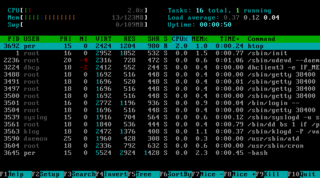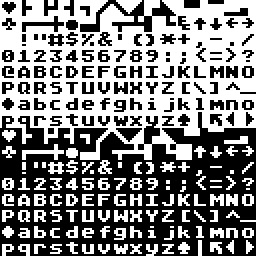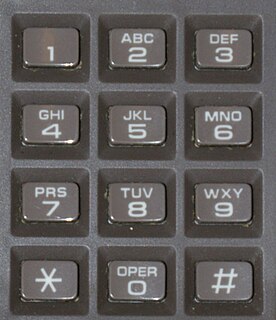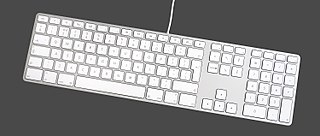
ASCII, abbreviated from American Standard Code for Information Interchange, is a character encoding standard for electronic communication. ASCII codes represent text in computers, telecommunications equipment, and other devices. Most modern character-encoding schemes are based on ASCII, although they support many additional characters.
The keyboard for IBM PC-compatible computers is standardized. However, during the more than 30 years of PC architecture being frequently updated, many keyboard layout variations have been developed.

A terminal emulator, or terminal application, is a computer program that emulates a video terminal within some other display architecture. Though typically synonymous with a shell or text terminal, the term terminal covers all remote terminals, including graphical interfaces. A terminal emulator inside a graphical user interface is often called a terminal window.

ANSI escape sequences are a standard for in-band signaling to control cursor location, color, font styling, and other options on video text terminals and terminal emulators. Certain sequences of bytes, most starting with an ASCII escape character and a bracket character, are embedded into text. The terminal interprets these sequences as commands, rather than text to display verbatim.

A computer terminal is an electronic or electromechanical hardware device that can be used for entering data into, and transcribing data from, a computer or a computing system. The teletype was an example of an early-day hard-copy terminal and predated the use of a computer screen by decades.

The VT220 is a computer terminal introduced by Digital Equipment Corporation (DEC) in November 1983. The VT240 added monochrome ReGIS vector graphics support to the base model, while the VT241 did the same in color. The 200 series replaced the successful VT100 series, providing more functionality in a much smaller unit with a much smaller and lighter keyboard. Like the VT100, the VT200 series implemented a large subset of ANSI X.364. Among its major upgrades was a number of international character sets, as well as the ability to define new character sets.

The ATASCII character set, from ATARI Standard Code for Information Interchange, alternatively ATARI ASCII, is the variation on ASCII used in the Atari 8-bit family of home computers. The first of this family are the Atari 400 and 800, released in 1979, and later models were released throughout the 1980s. The last computer to use the ATASCII character set is the Atari XEGS which was released in 1987 and discontinued in 1992. The Atari ST family of computers use the different Atari ST character set.

The VT50 was a CRT-based computer terminal introduced by Digital Equipment Corporation (DEC) in July 1974. It provided a display with 12 rows and 80 columns of upper-case text, and used an expanded set of control characters and forward-only scrolling based on the earlier VT05. DEC documentation of the era refers to the terminals as the DECscope, a name that was otherwise almost never seen.

A compose key is a key on a computer keyboard that indicates that the following keystrokes trigger the insertion of an alternate character, typically a precomposed character or a symbol.

Arrow keys or cursor movement keys are buttons on a computer keyboard that are either programmed or designated to move the cursor in a specified direction. The term "cursor movement key" is distinct from "arrow key" in that the former term may refer to any of various keys on a computer keyboard designated for cursor movement, whereas "arrow keys" generally refers to one of four specific keys, typically marked with arrows.

A keypad is a block or pad of buttons set with an arrangement of digits, symbols, or alphabetical letters. Pads mostly containing numbers and used with computers are numeric keypads. Keypads are found on devices which require mainly numeric input such as calculators, television remotes, push-button telephones, vending machines, ATMs, Point of Sale devices, combination locks, and digital door locks. Many devices follow the E.161 standard for their arrangement.

Apple Inc. has designed and released dozens of keyboard models since the introduction of the Apple II in 1977. The current models in use are dual-mode keyboards with integrated batteries: Magic Keyboard, and Magic Keyboard with Numeric Keypad. Both share a similar look and feel, based on a very thin aluminum chassis and laptop-style low-profile keys, sitting much closer to the tabletop than traditional keyboard designs.
On personal computers with numeric keypads that use Microsoft operating systems, such as Windows, many characters that do not have a dedicated key combination on the keyboard may nevertheless be entered using the Alt code. This is done by pressing and holding the Alt key, then typing a number on the keyboard's numeric keypad that identifies the character and then releasing Alt.

The Gold key is a computer keyboard key used as a prefix to invoke a variety of single-key editing and formatting functions. Usually located in the top-left position of the numeric keypad on platforms such as the VT100, it is the signature element of a consistent user interface implemented by Digital Equipment Corporation across multiple product lines.

The LK421 was a detachable computer keyboard manufactured by Digital Equipment Corporation of Maynard, Massachusetts and supplied as an option to the standard LK401 keyboard with their DEC 3000 AXP workstations. The keyboard is optimized for use with the Digital Unix line of operating systems, instead of the OpenVMS operating system for which the LK401 was more suitable.
The delete control character is the last character in the ASCII repertoire, with the code 127. It is supposed to do nothing and was designed to erase incorrect characters on paper tape. It is denoted as ^? in caret notation and is U+007F in Unicode.

A computer keyboard is a peripheral input device modeled after the typewriter keyboard which uses an arrangement of buttons or keys to act as mechanical levers or electronic switches. Replacing early punched cards and paper tape technology, interaction via teleprinter-style keyboards have been the main input method for computers since the 1970s, supplemented by the computer mouse since the 1980s.

The delete key is a key on most computer keyboards which is typically used to delete either the character ahead of or beneath the cursor, or the currently-selected object. The key is sometimes referred to as the "forward delete" key. This is because the backspace key also deletes characters, but to the left of the cursor. On many keyboards, such as most Apple keyboards, the key with the backspace function is also labelled "delete".
The Hazeltine 2000 is one of the first general-purpose "smart" computer terminals, introduced in October 1970 at a price of $2,995. While earlier terminal systems included "smart" editing features, notably the IBM 2260, the Hazeltine 2000 was the first that used a standard RS-232 interface and sent its control sequences in the data stream. It could be attached to any contemporary minicomputer or mainframe that had a serial port and used ASCII-standard character sets.

ECMA-23 is a standard for a bit-paired keyboard layout adopted in 1969 and revised in 1975. As a bit-paired layout, shifted keys correspond to toggling bits in the ASCII keycode. This is most visible in the digits on the top row, where shifting 6789 give &'(), and ;+, :* and -= are paired.
















